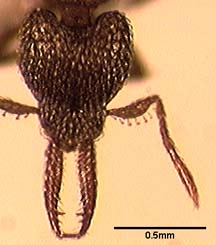
Specimen: Costa Rica, Prov. Heredia: 14km N Volcan Barba, 1220m (J. Longino 1342-s). INBIOCRI001283983. Image by J. Longino.
Identification
Apical fork of mandible with two tiny intercalary teeth; mandible with 5 preapical teeth/denticles, the middle tooth distinctly larger than flanking denticles (as in figure).
Measurements: head length 0.754mm, mandible length 0.504, head width 0.648, CI 86, MI 67 (n=1).
Range
Costa Rica (Atlantic slope to 1600m).
Natural History
Brown and Wilson (1959) summarize the genus as follows:
"Widespread in tropics and warm temperate areas. Primarily forest-dwelling; some species occur in grassland and arid scrub. ... Nests mostly in soil and rotting wood; a few species live in arboreal plant cavities in tropical rain forest. Foraging hypogaeic to epigaeic-arboreal. Food: most species are collembolan feeders; a few are polyphagous predators or occasionally feed on sugary substances..."
This species occurs in wet forest habitats, from lowlands to cloud forest. It is most abundant in mid-elevation and cloud forest sites, decreasing in abundance at lower elevations. It inhabits leaf litter on the forest floor.

Specimen: Costa Rica, Prov. Heredia: 14km N Volcan Barba, 1220m (J. Longino 1342-s). INBIOCRI001283983. Image by J. Longino.
